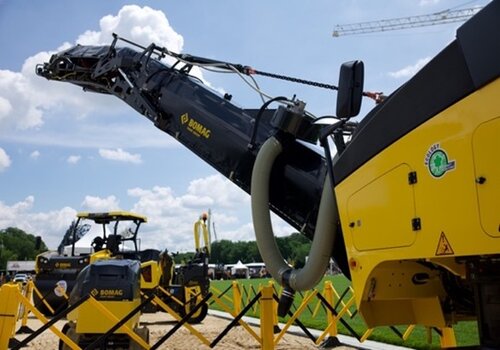It is not always easy to produce a consistently high-quality pavement. Two new technologies that may help in this area are thermal imaging, which measures the temperature of the mat behind the paver, and intelligent compaction. These can provide paving crews and engineers with information that may be used to improve consistency of paving and compaction operations.
Tim Kowalski, Hamm Applications Support Manager, says both technologies have merit on their own but both can also give us a broader understanding of how to manage technology in our businesses.
What is Thermal Imaging?
Thermal imaging uses and infrared (IR) bar that hangs off the back of the paver, just behind the screed, and uses infrared sensors to monitor pavement temperature. The number of sensors varies to match the paving width. Those sensors provide real-time information on temperature and while the system saves the data for later analysis.
What is Intelligent Compaction?
Intelligent compaction debuted in 2007, saw wider use starting in 2011, and now is used on about 1,000 projects each year. The tool provides the information needed to compact the mat optimally while minimizing over-compaction. This reduces cost and improves the long-term performance of the pavement. The system can be factory-ordered or upfitted later to Hamm rollers. Hamm also provides a gateway portal so that systems from Topcon and Trimble can use Hamm OE sensors.
Technology Lessons Learned
Here are the top five things learned from these paving technologies that we can apply to our use of technology in general.
1. Know the requirements of your market. “States vary in their requirements for thermal imaging,” says Kowalski. “Some are merely interested, some are in trial and testing, some require it but only on specific projects.” He says it will likely be three to five years before the majority of agencies start requiring the type of data thermal imaging provides.
2. Understand the limitations. “I prefer the term ‘GPS mapping’ to ‘intelligent compaction,'" says Kowalski. “The latter implies the technology controls machine function, as it does on a dozer, which it does not on a roller. It provides good information but it’s up to the operator and the contractor to make adjustments based on that information.”
3. Understand the data. Intelligent compaction provides information on pass count, stiffness and temperature. Know what the numbers mean. “Thermal imaging can indicate two types of problems,” says Kowalski, “sporadic or consistent.” Sporadic issues can result from the number of stops the paver makes, the number of trucks in use, the unloading procedures and more. An example of a consistent problem would be a streak in the mat, which suggests possible paver setup issues.
4. Look to the future. Infrared bars were a first step in thermal imaging and were a real boon to the industry when introduced, but their mapping accuracy and data-gathering capabilities are now being eclipsed by emerging technologies that use infra-red cameras and more sophisticated sensors. If you have an IR bar, consider upgrading. If you don’t, consider skipping that device and starting out with a more sophisticated system. As for intelligent compaction, many contractors are adopting it now even if it’s not being required in their market at this time. “They know it will eventually become a requirement and they want to have the equipment and expertise in place when that day comes,” says Kowalski.
5. Understand your agencies. They’re not contractors and they don’t have a contractor’s mindset. “They may require the information provide by thermal imaging or an intelligent compaction system,” says Kowalski, “but they’re not analyzing it at the end of each day. It’s more likely they won’t look at it until the end of the week or even the end of the project.” And the data aren’t there to provide a basis for finger pointing by the agency. “Both thermal imaging and intelligent compaction are data-gathering tools allowing agencies and contractors the ability to acquire, access, and analyze project-related information together to build future projects better.”
Kowalski will lead an education session — Using New Technologies in Asphalt Paving — at CONEXPO-CON/AGG 2020 in Las Vegas on Tuesday, March 10, from 3:00 to 4:00 p.m.












